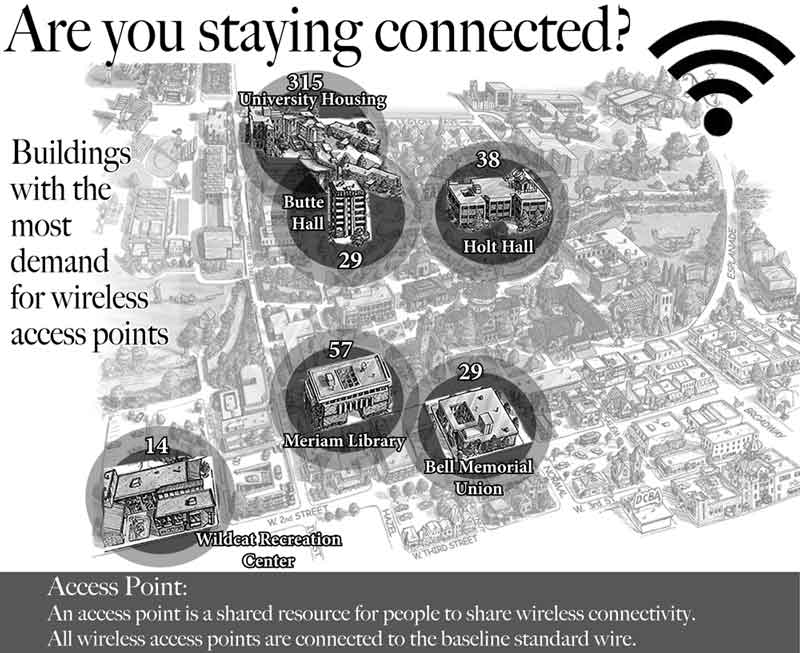
Chico State’s aging wire infrastructure is being replaced in order to meet demands of growing numbers of unique devices.
Because there are roughly 2.5 electronics per person, 20,000 unique devices use the Chico State campus Internet at any given time every day.
“In the last five years, we’ve seen an explosion of wireless devices coming on to the network,” said Scott Claverie, director of telecommunications services at Chico State.
Claverie is responsible for reporting systemwide growth of Internet usage in order to address additional needs for access points.
In 2000, the chancellor’s office implemented the Technology Infrastructure Initiative, which prompted the renovation and installation of new cabling and network electronics for all California State University campuses.
The goal was to create a baseline standard of wired connectivity speed in order to support the data needs of the school system, Claverie said.
The standard wired connectivity speed is one gigabit-per-second, according to the initiative.
Only 18 out of 25 buildings on campus have reached the standard speed of one gigabit-per-second for wired services that connect to desktops on campus, Claverie said.
Meriam Library and Kendall Hall are among buildings that don’t meet the standards. In order to run newer, faster cables inside the walls, pathways would have to be constructed to house those wires.
The telecommunications department does not have enough funding to upgrade buildings that only meet sufficient wire connectivity.
The Technology Infrastructure Initiative project allocated $243.6 million to build on telecommunications infrastructure for all 23 California State University campuses over a three-year period.
There hasn’t been any money identified at the campus level to fix some buildings so some funding comes from the telecommunications services department, Claverie said.
The Technology Infrastructure Initiative project fixed the wire infrastructure inside buildings and dug trenches in the ground in order to run copper and fiber connecting conduits from each building to the next.
This summer, Claverie will be working on completing full replacement of cables on the first and second floors of O’Connell Technology Center, he said. He will also be replacing core equipment that connects all the buildings’ wires together.
The core equipment is built in a way so that wired connectivity can distribute and be received to and from other buildings. If any one of the connections fail, the building would still have connection coming in from a different building.
It will cost about $300,000 to replace the equipment, Claverie said.
“Electronics need replacing because they get old,” he said. “The other thing is the speed on the connections are starting to increase more and more every year. It just goes to supply the demand, the need out there for faster connectivity so the equipment can only go so fast so we upgrade it to go faster.”
Claverie said the trend of unique device usage has continued to rise.
“It’s funny because we’d always see a little blip that comes up around spring semester because after the students come back from Christmas, they have a new toy,” he said.
Claverie said the department looks at heat maps of a building in order to determine the need for more access points for wireless connectivity. Heat maps identify areas within a building that require the most Internet usage.
When one access point has reached the threshold of 30 users allowed, another access point is put out to divert the demand in one heavily used area.
“If any student feels that their service is lacking or they have a problem connecting, call the help desk,” Claverie said. ” We want your experience to be a great one. We’ve designed a network that certainly works extremely well and we want to make sure that you’re taking advantage of it.”
Christine Lee can be reached at klee@theorion.com or @leechris017 on Twitter.





